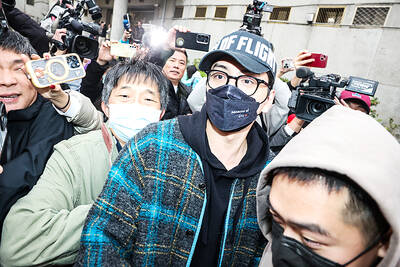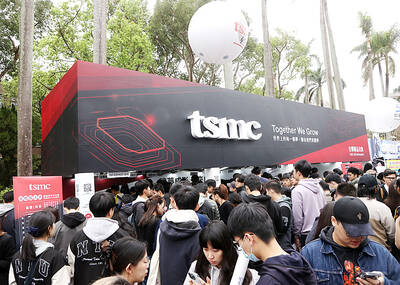Pediatricians yesterday urged parents and doctors to watch this season for an occurrence of Kawasaki disease, an illness that often strikes children under the age of five.
Kawasaki disease, also known as lymph node syndrome or the Kawasaki syndrome, is a leading cause of acquired heart disease in children in Japan, South Korea and Taiwan, as well as other children of Asian extraction, said Lu Hung-chi (呂鴻基), executive director of the Cardiac Children’s Foundation Taiwan.
Children, particularly those under the age of five living in Japan, South Korea and Taiwan, may be vulnerable to the disease during its peak season, covering the months of April to June, Lu said in a speech at the Ninth International Kawasaki Disease Symposium that opened at the Grand Hotel in Taipei yesterday.
First discovered in 1967 by Tomisaku Kawasaki in Japan, the disease is a poorly understood self-limited vasculitis that affects many organs, including the skin and mucous membranes, lymph nodes, blood vessel walls and the heart.
Lu said parents and pediatricians should pay extra attention if children in their care have a fever for more than five days and show other symptoms such as a rash, swollen hands and feet, red eyes, swollen lymph glands in the neck, and irritation and inflammation of the mouth, lips and throat.
In Taiwan, about 66 out of every 100,000 children under five are affected by Kawasaki disease, compared with 188 in Japan and 105 in South Korea, Lu said.
He said that the number of Kawasaki disease cases in Taiwan had gradually increased over the past 10 years, with 800 to 1,000 cases being diagnosed annually in the last two years.
“In the absence of proper treatment, as many as 20 to 30 percent of the children with Kawasaki disease could suffer complications that affect the heart,” Lu said. “Their coronary arteries and heart muscles could be damaged.”
Doctors still do not know what causes Kawasaki disease, but it does not appear to be hereditary or contagious. Researchers who have studied the illness think evidence strongly suggests it is caused by an infectious agent such as a virus. It is very rare for more than one child in a family to develop Kawasaki disease and less than 2 percent of children have a repeat attack.
Wu Mei-huan (吳美環) , a leading pediatrician at National Taiwan University Hospital, said at the symposium that Kawasaki disease was not easy to diagnose as many of its symptoms were similar to the flu.
“Doctors are encouraged to use endocardiography to diagnose the little patient, if a child shows four to five of the symptoms of Kawasaki disease,” Wu said.
Even though the cause of Kawasaki disease is unknown, certain medications are known to help, the Cardiac Children’s Foundation Taiwan said.
Aspirin is often used to reduce fever, rashes, joint inflammation and pain, and to help prevent blood clots. Another treatment, intravenous gamma globulin, can help decrease the risk of developing coronary artery abnormalities if administered during the early stages of the illness, they said.

Actor Darren Wang (王大陸) was questioned by prosecutors for allegedly orchestrating an attack on a taxi driver after he was allegedly driven on a longer than necessary route in a car he disliked. The questioning at the New Taipei City District Prosecutors’ Office was ongoing as of press time last night. Police have recommended charges of attempted murder. The legally embattled actor — known for his role in the coming-of-age film Our Times (我的少女時代) — is under a separate investigation for allegedly using fake medical documents to evade mandatory military service. According to local media reports, police said Wang earlier last year ordered a

CAUTION: Based on intelligence from the nation’s security agencies, MOFA has cautioned Taiwanese travelers about heightened safety risks in China-friendly countries The Ministry of Foreign Affairs (MOFA) yesterday urged Taiwanese to be aware of their safety when traveling abroad, especially in countries that are friendly to China. China in June last year issued 22 guidelines that allow its courts to try in absentia and sentence to death so-called “diehard” Taiwanese independence activists, even though Chinese courts have no jurisdiction in Taiwan. Late last month, a senior Chinese official gave closed-door instructions to state security units to implement the guidelines in countries friendly to China, a government memo and a senior Taiwan security official said, based on information gathered by Taiwan’s intelligence agency. The

President William Lai (賴清德) should protect Taiwan Semiconductor Manufacturing Co (TSMC), and stop supporting domestic strife and discord, former president Ma Ying-jeou (馬英九) wrote on Facebook yesterday. US President Donald Trump and TSMC on Monday jointly announced that the company would invest an additional US$100 billion over the next few years to expand its semiconductor manufacturing operations in the US. The TSMC plans have promoted concern in Taiwan that it would effectively lead to the chipmaking giant becoming Americanized. The Lai administration lacks tangible policies to address concerns that Taiwan might follow in Ukraine’s footsteps, Ma wrote. Instead, it seems to think it could

Taiwan Semiconductor Manufacturing Co (TSMC), the world’s largest contract chipmaker, said yesterday that it is looking to hire 8,000 people this year, at a time when the tech giant is expanding production capacity to maintain its lead over competitors. To attract talent, TSMC would launch a large-scale recruitment campaign on campuses across Taiwan, where a newly recruited engineer with a master’s degree could expect to receive an average salary of NT$2.2 million (US$60,912), which is much higher than the 2023 national average of NT$709,000 for those in the same category, according to government statistics. TSMC, which accounted for more than 60 percent